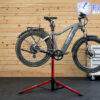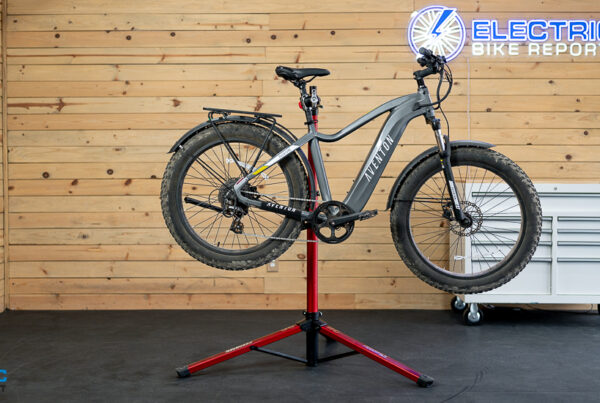Some links may be affiliate links. We may get paid if you buy something or take an action after clicking one of these.
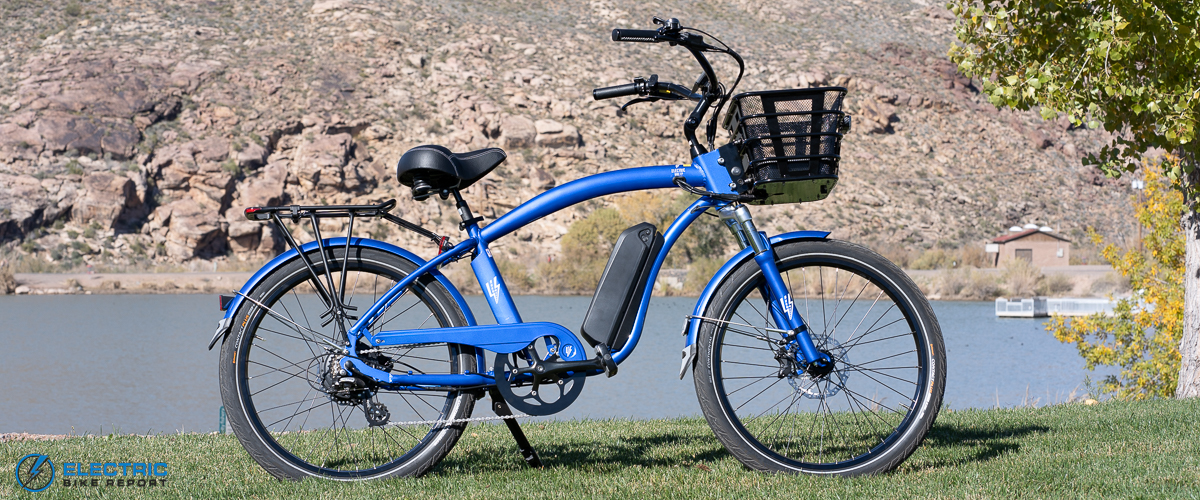
In a world where most electric bike companies make nearly every style of e-bike under the sun, Electric Bike Company is something of a specialist.
Instead of attempting to be a master of all, the southern California-based manufacturer has put all their design and engineering chips into just one style of e-bike: Electric beach cruisers. The result is an offering of supremely comfortable, excellent handling and remarkably customizable lineup of e-bikes purpose built for cruising the coast or your local bike path. In this Electric Bike Company Model C review, we’re going to take an in-depth look at EBC’s high-step beach cruiser to get a feel for how it performs in the real world. Spoiler alert: it ride’s as you’d expect a laid back comfort cruiser would.
We’ve reviewed several of Electric Bike Company’s e-bikes over the past several years, so we’re well versed in the company’s modus operandi of heavily customized and high-performing e-bikes. In this case, the Model C we reviewed was decked with a host of upgrades including a dual battery system and a 7-speed drivetrain, among many other things.
To test the Model C’s capabilities, we put the bike through a gauntlet of stress tests designed to demonstrate how the bike performs on climbs, under hard braking and in a myriad of other scenarios so you can get an idea of how it performs.
Bike Category: Beach Cruiser
Bike Class: Class 3: PAS to 28 mph/Throttle assist up to 20 mph
Electric Bike Company Model C Video Review

 Pro’s
Pro’s- Our Model C had the expanded range 21Ah battery, which gave the bike a very impressive range.
- The Model C is an extremely nice riding e-bike that’s easy to handle.
- EBC really prides itself on their builds and it shows in the quality of the bike. Simple things like cable management are taken to the next level.
- It’s a large bike, but doesn’t ride like a behemoth. The cruiser-styling makes it accessible to people of different heights and it handles its size well.
- The customization options are bar-none. It’s really cool how detailed you can get.
- Did we mention it’s comfortable? It feels like you’re pedaling a Cadillac.

 Con’s
Con’s- EBC’s bikes are fairly large and long, making them a bit boat-like in tight situations. A small price to pay for comfort.
- The included alarm system is a nice security feature, but it can chirp unexpectedly and at a very high volume.
ELECTRICAL SPECS & FEATURES
- Battery: 48V, 12Ah (576Wh) frame-mounted battery & 48V, 9Ah (432Wh) rack-mounted battery — 1,008Wh total.
- Display: Full-color LCD display
- Motor: 500W rear hub motor
- Headlight: Yes, integrated
- Taillights: Yes, integrated
- Peal Assist: 5 PAS levels
- Range: Up to 110 miles (claimed)
- Throttle: Thumb throttle
Weight & Dimensions
- Claimed weight: 53 lbs
- Maximum rider weight: 300 lbs
- Maximum load on rear rack: 59 lbs (27kgs)
Components & Accessories
- Brakes: Tektro Dorado hydraulic disc brakes, four piston
- Fenders: Optional (Our test bike had them)
- Fork: Rigid steel, with an option to upgrade to a suspension fork
- Frame: Aluminum
- Drivetrain: Single speed with an option to upgrade to 7-speed Shimano Altus
- Grips: Faux leather comfort grips
- Saddle: Custom leather saddle
- Handlebar: Steel cruiser bars
- Kickstand: Heavy duty steel
- Pedals: Wellgo aluminum
- Tires: Schwalbe Fat Frank or upgraded Continental Contact Plus City E50
Electric Bike Company Model C Performance Review
Bike Overview
As we’ve mentioned before, Electric Bike Company’s e-bikes are astonishingly customizable.
The base version of the Model C, which starts at an MSRP of about $2,000, comes with a 500W rear hub motor, 12Ah frame-mounted battery, a rigid steel fork and single-speed drivetrain — all pretty typical of what you’d expect from an affordably priced electric beach cruiser. But stock bikes are not what Electric Bike Company is known for, rather customization is how this company has made its name.
EBC assembles and even manufactures much of its bikes at its Newport Beach headquarters, giving them (and ultimately you) an astonishing amount of control over every bike they sell. Through an online bike designing tool, you can pick and choose color, drivetrain options, battery options, suspension options and whether you’d like to include accessories like baskets, locks or GPS trackers. They even build their own wheels and batteries in house, so you can go as far as choosing your rim and spoke colors and the color of the battery casing. It wouldn’t be a stretch to say that EBC likely offers the most extensive customization menus in the entire direct to consumer e-bike market; the amount of control each buyer has over the fit and finish of their bike is pretty wild.
So naturally, the Model C we reviewed was not the base model. Our test bike sported a custom paint job, a suspension seatpost, an MIK rear rack, upgraded tires, a 7-speed Shimano drivetrain and an upgraded dual battery system that gave the bike a whopping 21Ah (1,008Wh) of available energy. While those features are upgrades over the base Model C, it’s obvious Electric Bike Company has taken a lot of care to build a frame and overall foundation that’s exceptionally well done. The bike rides smooth and the geometry is notably comfortable, two characteristics you should expect from any Model C regardless of how you build it.
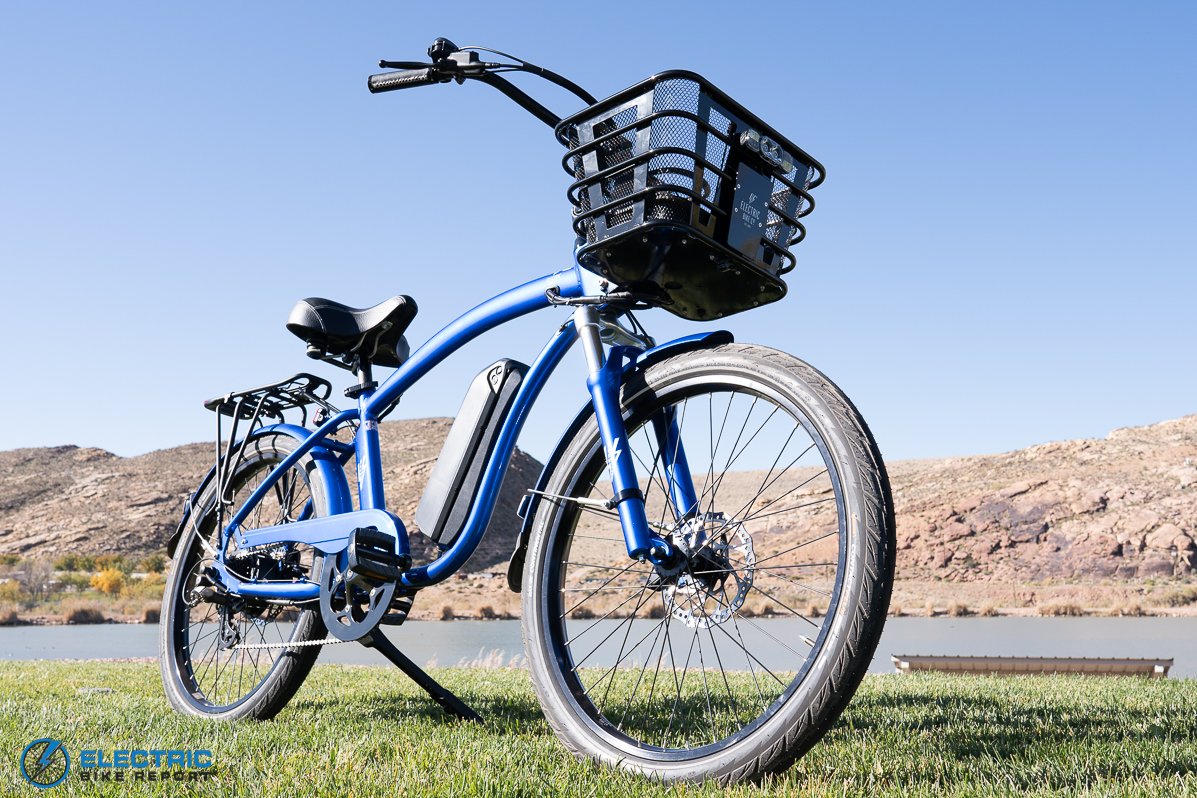

The Electric Bike Company Model C is an incredibly comfortable electric beach cruiser that’s astonishingly customizable; you can choose everything from the paint color to the drivetrain.
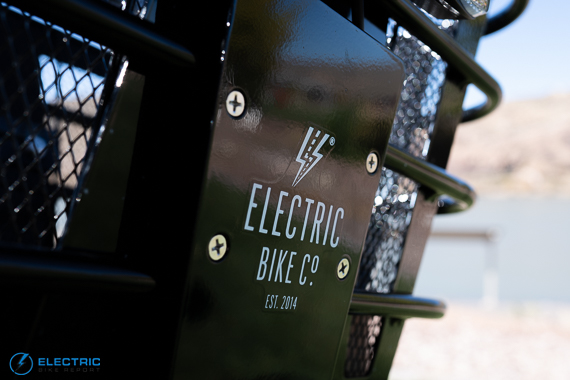

Some nice detail on our Model C’s front basket, which also houses the secondary 48V, 9Ah battery.
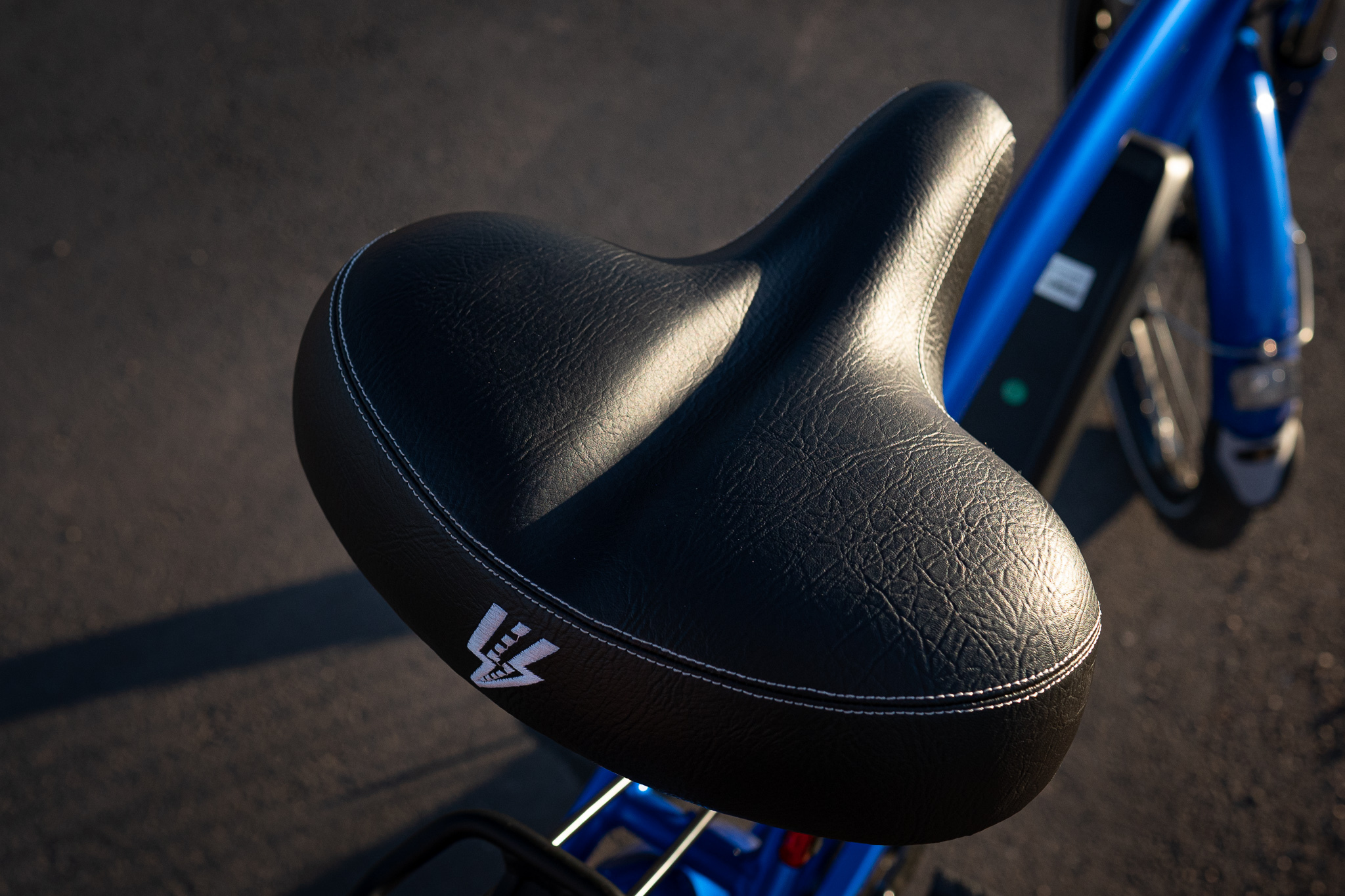

Like any good cruiser, the Model C’s seat is big, cushy and comfortable.
Range Test & Battery Performance
The particular Model C we reviewed was fitted with a dual battery system so large it’s unlikely you’d ever run the bike dead on a typical ride.
In addition to the stock 48V, 12Ah battery mounted to the downtube, our Model C had a secondary 48V, 9Ah battery mounted in the bottom of a basket bolted to the front of the bike. In total, the two batteries make for a whopping 1,008Wh of combined energy. That’s a lot of juice.
We conducted two real-world range tests to see how far this dual battery system could take us, and the results were pretty impressive. On the first range test, which we conducted in the highest pedal assist setting (PAS 5) to see how far the bike could go on max power, the Model C went for 32.83 miles at an average speed of 19.1 mph. And on the second range test, which we conducted on PAS 2 to stretch battery life as long as possible, we made it an astonishing 83.1 miles with an average speed of 13.5 mph.
Both those range test results are impressive, but the battery life we saw in the low power range test is really remarkable. In fact, the Model C’s 83.1 mile result in PAS 2 is the longest distance range test we’ve seen to date. The wild thing is the bike would have likely gone much further had we chosen to do the low power range test on PAS 1, the Model C’s lowest assist level. We opted for PAS 2 over PAS 1 because we do our low power range test using the lowest assist level our test rider feels a consistent amount of assistance from the motor. Electric Bike Company says the Model C’s motor and battery configuration should yield a 110 mile max range, which I’m inclined to believe after seeing the result of the PAS 2 test.
Circuit Test and Motor Performance
The Model C ships as a Class 3 e-bike with a 500W motor that’ll assist your pedaling up to 28 mph. It also has a thumb-actuated throttle on the left side of the handlebars that’ll cut off at 20 mph.
It’s a quick bike — the 19.1 mph average speed over our 32.83 mile range test is evidence of that — but we also saw that bike’s speed during our circuit test. This test, which we conduct on an uninterrupted 1 mile loop with a small hill, is intended to not only demonstrate the bike’s high speed performance, but also how the motor delivers power in each assistance level.
We did a total of six laps around our circuit on the Model C, one lap for each of the five pedal assist levels plus a lap with the motor turned off to get a baseline of how the bike rolls on its own.
With no help from the motor, the Model C turned a lap with a respectable 13 mph average speed, which is solid considering it’s not a particularly light bike and beach cruisers aren’t known for pedaling efficiency. From there on out, we saw nice even jumps in average speed as we did laps in each of the five pedal assist levels. On average, we saw about a 2 mph change in speed as we cycled through the assist settings. The only exception was PAS 1, which only saw a slight 0.6 mph improvement over pedaling the bike with the motor turned off. We’re not going to knock the Model C for this, though, as this is something we see on nearly every e-bike we test.
So what’s this data tell us? In short, it means riders have very good control over just how much energy and power they want to use when riding the Model C. It’s also a good indication that Electric Bike Company has done a nice job tuning their bike.
On the PAS 5 lap, the highest pedal assist setting, the Model C turned a hot lap with an average speed of 22.3 mph — a high speed for a style of bike more inclined towards coastal cruising than aggressive riding. I’d partially credit this result to the geometry that, while very upright and comfortable, feels very stable in corners and at higher speeds. It’s also likely thanks to our review bike’s upgraded Continental Contact Plus City E50 tires which have a fast-rolling semi slick tread pattern that hooked up well and felt planted.
It’s also a respectable result from a bike with a 500W motor. While not as torquey or hot-rod fast as some of its 750W brethren, the Model C has a satisfyingly quick power profile with quick low speed acceleration and plenty of power to maintain a fast cruising speed.
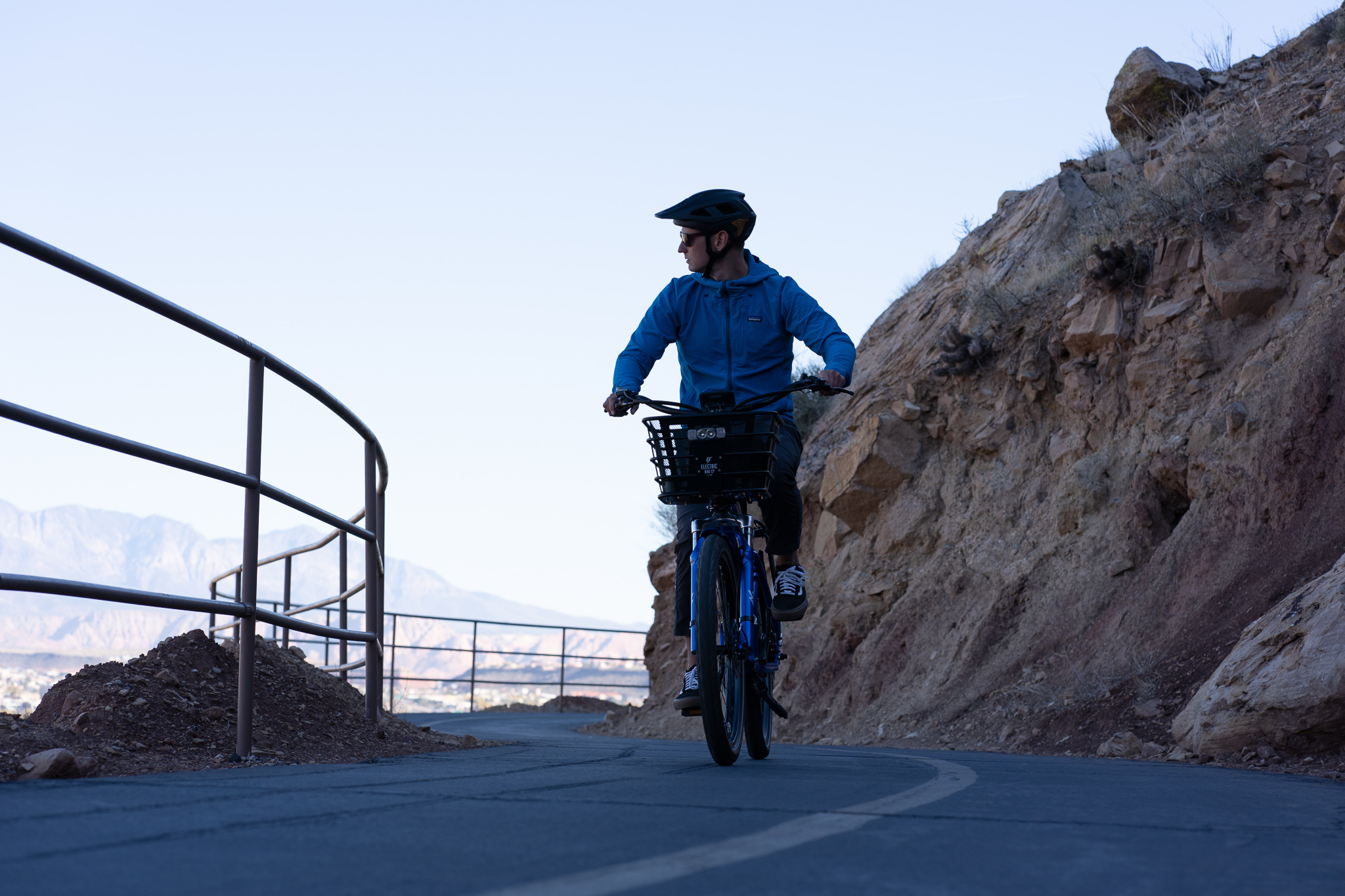

The Model C is a Class 3 e-bike with a 500W rear hub motor. Among beach cruisers, it’s a very quick bike.
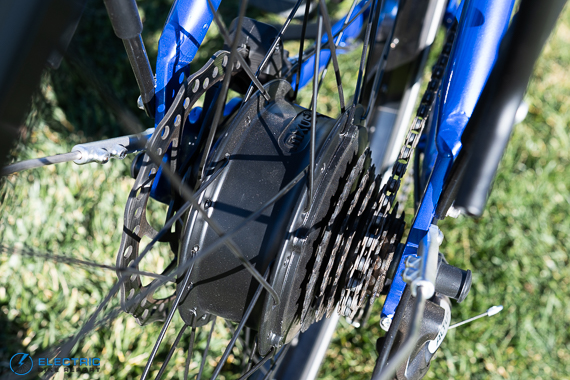

The 500W rear hub motor has more than enough power.
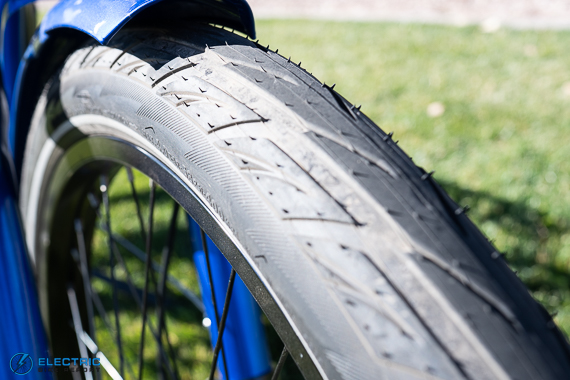

The semi-slick Continental Contact Plus City E50 tires roll fast and hook up very, very well in corners.
Hill Test and Drivetrain Performance
On our test hill, a local steep called Hell Hole that’s a third of a mile long with an average grade of 12 percent, the Model C had some surprising results.
We took the Model C up Hell Hole two times to test its climbing abilities — once using just the throttle to see how the motor performs on its own and again on PAS 5 to see how the motor meshes with a rider’s pedaling.
While the PAS 5 test went about how we expected — the Model C cleared the top in 1:43.00 with an average speed of 10.5 mph — it was the throttle-only test that threw us a curveball. Unfortunately, the Model C didn’t clear our test hill under motor power alone.
It’s not at all uncommon for an e-bike to not make it up Hell Hole during the throttle only test. We chose our test hill specifically for its length and sustained grade, which combined makes for a hill tough enough to strain even the most powerful e-bikes. Several really good e-bikes we’ve reviewed have been bested by the throttle test on Hell Hole, including the Radio Flyer M880 we recently reviewed. But why the Model C’s result was surprising is because it’s the first Electric Bike Company e-bike we’ve reviewed that didn’t make it to the top on throttle power alone.
This result may largely be due to the simple fact that I’m heavier than my Electric Bike Report colleague Pierce Kettering, who has conducted all the EBC e-bike reviews up until this one. Like all our tests, the hill test is subject to a myriad of variables from rider weight to temperature that can have bearing over the result.
Either way, I have a hard time knocking the Model C for its performance on the throttle-only portion of the hill test — mostly because of how well it performed in the PAS 5 hill test. With a little help from my legs, the Model C cleared Hell Hole with ease. It’s like the few additional Newton meters of torque my pedaling added was just enough to get the bike over the top.
The Model C’s upgraded 7-speed drivetrain was also a huge help in the PAS 5 test. Our bike had a Shimano Altus rear derailleur controlled by a Shimano Tourney thumb shifter; a reliable and cost-effective pairing we often see on more affordable e-bikes. The shifting is crisp and performs well under load.
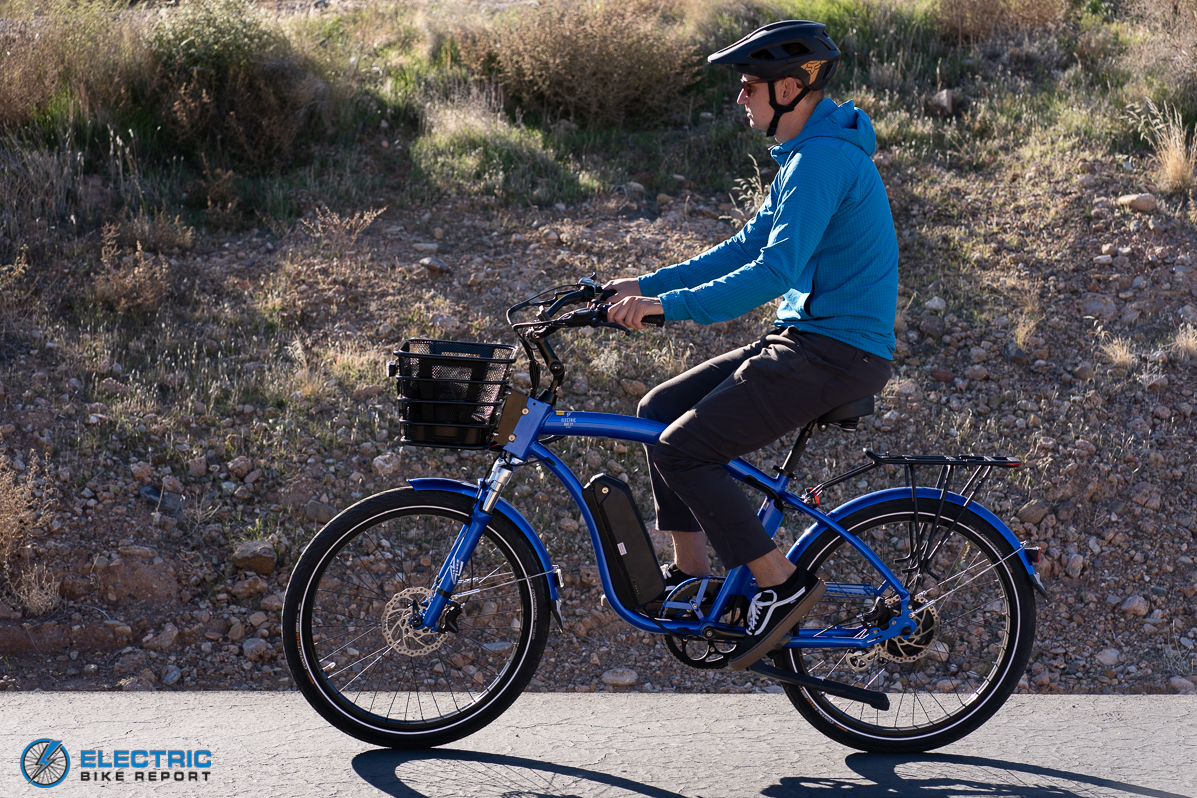

If electric beach cruisers had a mantra it would be comfort over pedaling position; you may not get good leg extension, but it rides like a Cadillac.
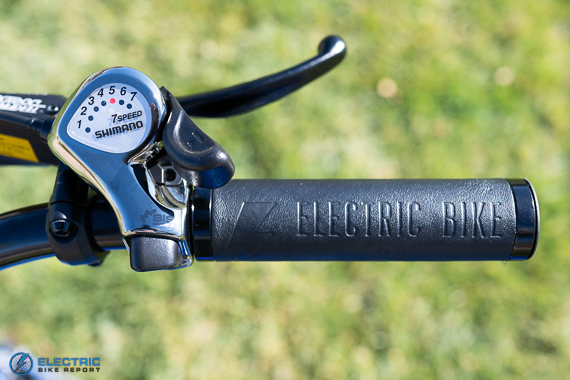

The Shimano Tourney 7-speed thumb shifter.
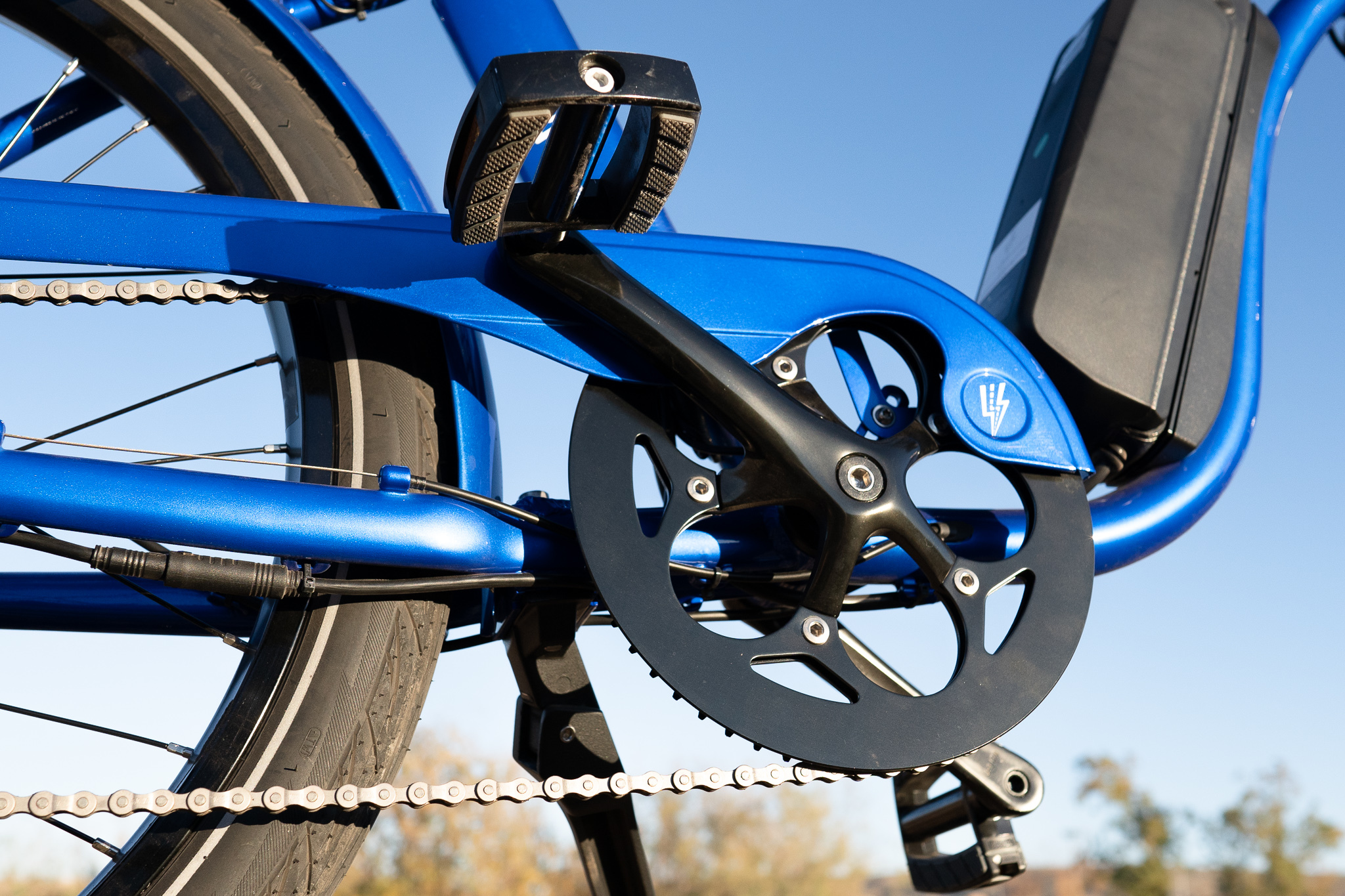

Electric Bike Company recently upgraded the chainring on the Model C to a whopping 58t version.
Brakes and Handling
You’ve got to love a really good set of brakes, especially on a bike quick enough and heavy enough to truly need substantial stopping power.
The Model C comes stock with a set of Tektro Dorado 4-piston hydraulic disk brakes with 180mm rotors front and rear, a setup that has no problem handling Class 3 speed and a bike that’s no featherweight.
These brakes performed impressively well in our braking test, coming to a stop on average in 14-feet-7-inches from 20 mph. That’s a better than average result when compared to the stopping distance of all the bikes we’ve reviewed thus far.
To be honest, this is a pretty surprising result from the Model C. That’s because powerful brakes are only part of the equation; you also need geometry conducive to good braking technique and tires with a compound grippy enough to grab into the pavement when they start skidding. The Model C appears to have the whole package. Not only was I able to safely shift my body into a good braking position, the tires still found grip after the powerful brakes locked up the wheel and the bike started to skid.
My one gripe about the handling is it really is a very long bike with a wide turning radius. This isn’t so much a knock against any EBC e-bikes in particular, but more of a symptom of the beach cruiser style in general. I noticed this mostly when pulling u-turns on the bike path where space was limited, but other than that the bike’s long wheelbase lends itself to very stable riding.
Ride Comfort, Geometry and Extras
Like any good beach cruiser, the Model C places a premium on its upright and very comfortable riding position.
It’s a very traditional beach cruiser geometry with swept-back handlebars and a seat angle that places your hips well behind the bottom bracket, helping ensure your feet will touch the ground while seated on the very broad and cushioned saddle. You also likely will not get a full leg extension while pedaling the bike, which again is pretty typical of beach cruisers and one of the reasons why they’re not the most efficient pedaling bikes on the market — but hey, that’s what you’ve got that 500W motor for.
The Model C (and all of EBC’s bikes) boast one of the best LCD displays in the biz. It’s full color, easy to read in bright sunlight and displays all your necessary riding information without having to toggle through a bunch of screens. Our review model also came with fenders front and rear that were painted to match the bike and a chain guard that also matches.
Our Model C also came with a rear rack rated for 59 lbs of cargo and equipped with the MIK racking system, which allows you to simply click in a host of useful accessories ranging from baskets to child seats. The bike’s secondary battery comes in basket form, which also increases the amount of stuff your bike can carry.
But arguably one of the coolest features isn’t actually part of the bike. Rather, it’s how it’s shipped. Electric Bike Company is one of the few direct to consumer e-bike brands that ships its bikes 99 percent assembled and ready to ride. Because of this, the bikes are shipped via a special shipping service and arrive on a pallet. All you need to do is open the box, slide the bike out and straighten the handlebars. Everything else, from the shifting to the brake alignment, is tuned and ready to ride.
While this may sound like a minor bonus, it’s actually a pretty big deal. I’d argue most e-bike buyers underestimate how much assembly and adjustment is required when they first receive their bikes, and it’s not all as intuitive as you might think.
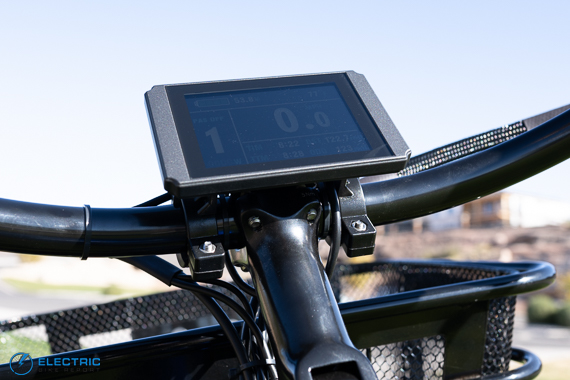

The LCD display is center mounted on the handlebars.


180mm disk rotors front and rear slow the bike down quickly.


Another optional accessory: Fenders painted to match the frame with integrated lights.
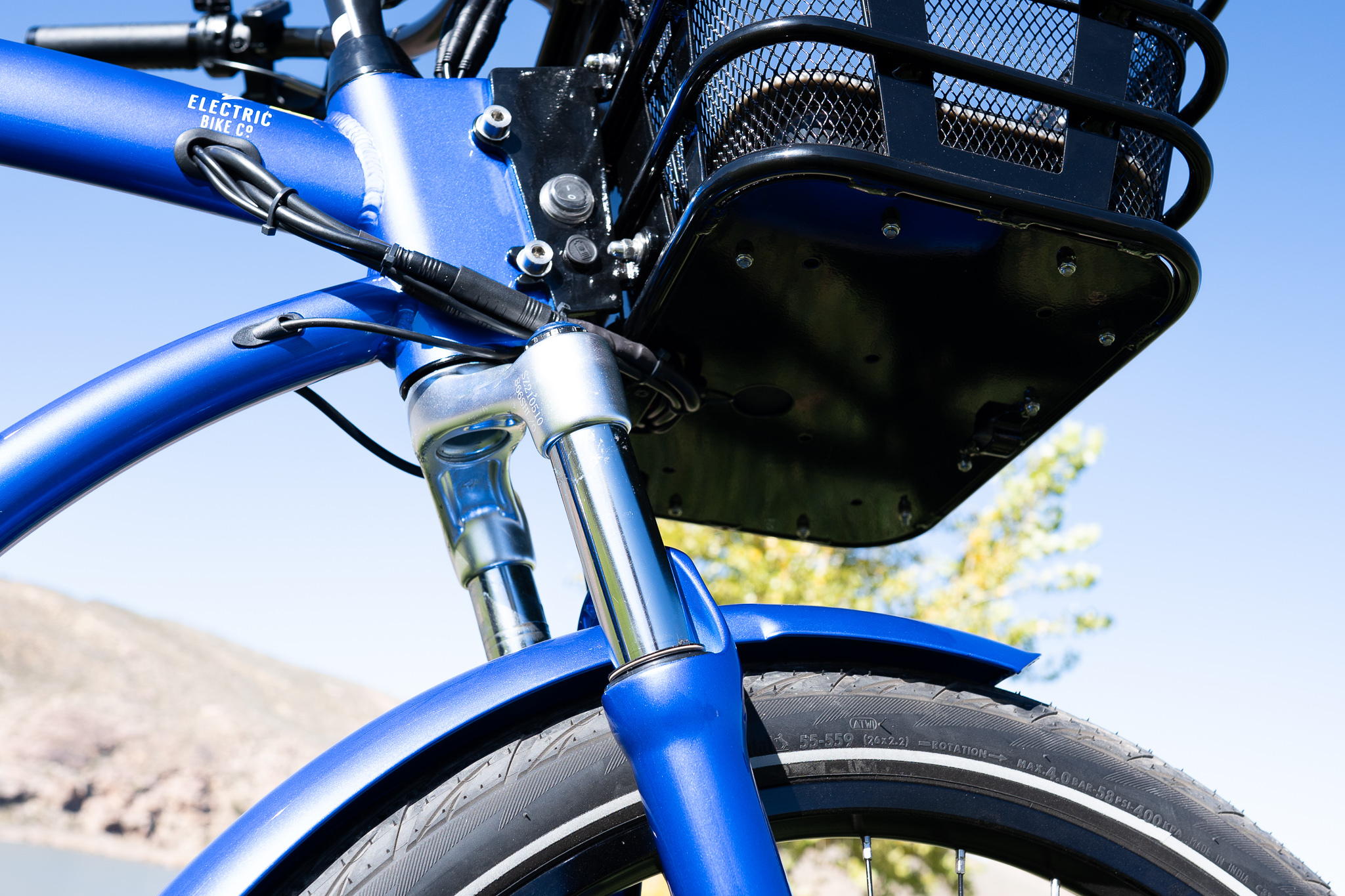

The Model C we reviewed had an upgraded suspension fork over the rigid steel fork that comes stock on the bike.
Electric Bike Company Model C Review: Summary / Where to Buy
Like all the Electric Bike Company e-bikes we’ve reviewed at Electric Bike Report, I’ve been very impressed with how the Model C has performed.
It’s not a perfect e-bike — we saw it have some issues on our test hill and the wide turn radius — but by and large Electric Bike Company seems to have made another very good e-bike in the Model C. It’s exceptionally comfortable, well spec’d and outperformed our expectations in many of our tests.
But while we’re pleased with how the bike performed, I’d argue some of the things that really make this bike great are strengths that are tough to capture in a stress test. The biggest of these is arguably the sheer amount of customization you can do to an Electric Bike Company bike. It really is astonishing how much you get to pick; from the rim color to the drivetrain, the options are almost overwhelming.
Electric Bike Company has seemingly built a whole e-bike company that excels at paying attention to the little details that few others do, and they’ve managed to make an exceptional e-bike by doing that. If you’re on the hunt for a nice riding e-bike that perfectly fits your style and needs, the Electric Bike Company Model C is definitely worth a look.
Electric Bike Company sells the Model C online from the button above and will ship the bike directly to your door. Or, if you prefer buying in person, they also have a growing network of brick and mortar dealers.
‘Happy Riding, make sure to let us know if you have any questions down in our comments section or if you think we left anything out in this review of the Electric Bike Company Model C
Reader Interactions
![]()
![]()
.
.
.
#Electric #Bike #Company #Model #Review #Custom #Cruising #Electric #Bike #Report
Source link


